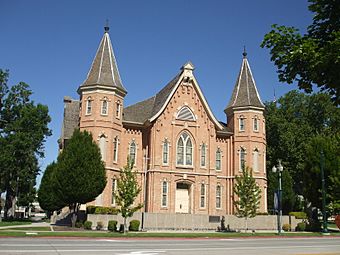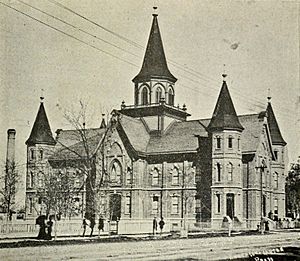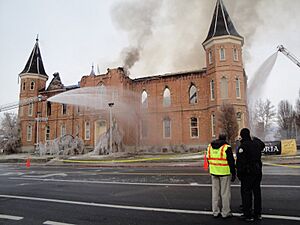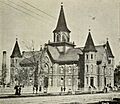Provo Tabernacle facts for kids
Quick facts for kids |
|
|
Provo Tabernacle
|
|

The Provo Tabernacle in 2009
|
|
| Location | 50 S. University Ave., Provo, Utah |
|---|---|
| Area | 1 acre (0.40 ha) |
| Built | 1883 |
| Architect | William H. Folsom |
| Architectural style | Gothic Revival |
| NRHP reference No. | 75001830 |
| Added to NRHP | September 9, 1975 |
The Provo Tabernacle was a historic building in Provo, Utah. It served as a large meeting place for the Church of Jesus Christ of Latter-day Saints from 1898 to 2010. This beautiful building was a symbol of Provo and hosted many religious and cultural events. In December 2010, a big fire destroyed most of the building, leaving only its outer walls. The Church decided to save these walls and rebuild the inside. It became the Provo City Center Temple, which was finished in 2016.
Contents
The First Provo Tabernacle
Before the well-known Provo Tabernacle, there was an older, smaller one. It was sometimes called the Old Provo Tabernacle. This first building stood from 1861 to 1919. It was located on the same block, just north of where the later tabernacle was built.
Plans for this first meeting house started as early as 1852. However, construction didn't begin until 1856. Wars in the area slowed down the building process. The first tabernacle could seat about 1,100 people. It had a single tower on its north side that was 80 feet (24 m) tall. This tower held a large, 500-pound (230 kg) bell.
The building was mostly ready by 1861. The final plastering and official dedication happened in 1867. At the dedication, Brigham Young said the building was "entirely too small." He felt it should have been finished much earlier. The original Provo Tabernacle was taken down between 1918 and 1919. In 2012, its old foundation was found. Workers discovered many coins and small items that had fallen through the floorboards.
Building the Second Tabernacle
Construction for the second, much larger Provo Tabernacle began in 1883. This building was also known as the Utah Stake Tabernacle. The Church built it to hold more people than the first one. Harvey H. Cluff was in charge of its construction.
The new tabernacle was designed by William Folsom. It could seat 3,000 people in its main area and balconies. The building was ready for use by 1886. It even hosted a big Church meeting called general conference on April 6 of that year. The tabernacle was officially dedicated on April 17, 1898. George Q. Cannon led the dedication, with Joseph F. Smith also attending. The building cost about $100,000 to build.
In 1907, a large organ was installed. It cost $10,000 and had many pipes. Later, in 1917, a small dome-like structure on the roof was removed. This was because the roof was starting to sag. In 1964, the tabernacle was updated. Much of the inside was painted white, and the electrical and heating systems were improved.
A Center for Community Events
The Provo Tabernacle was a very important place for the community. It hosted many concerts, Church meetings, and other local events. Famous performers, like Madame Abbie Carrington, performed there in 1891. In 1909, U.S. President William H. Taft visited and spoke at the tabernacle.
In the 1930s, Brigham Young University (BYU) started using the tabernacle for its arts programs. A very famous event happened in 1938 when the composer Sergei Rachmaninoff performed a concert there. Many funerals for important Provo residents were also held in the tabernacle. In 1975, the building was added to the U.S. National Register of Historic Places. This list recognizes places important to history.
The Fire of 2010
On December 17, 2010, a large fire broke out at the tabernacle. Firefighters arrived early in the morning to find smoke. They hoped to save the roof and the building's structure. However, around 6:00 AM, the roof collapsed. The fire continued to burn for the rest of the day.
After a long investigation, the Provo City Fire Department shared its findings. They believed the fire started because a hot lamp was placed too close to wooden materials. This lamp was being used for rehearsals. The report also noted that the building did not have a modern fire protection system. There were also some human errors that contributed to the fire spreading.
Some valuable items were lost in the fire. A large painting of Jesus Christ, called The Second Coming, was partly saved. While some parts of it burned, much of Jesus's figure remained. Another important painting, Restoration of the Melchizedek Priesthood by Minerva Teichert, was almost completely destroyed. The fire also ruined a large pipe organ, a grand piano, a harp, and TV equipment.
Rebuilding as a Temple
On October 1, 2011, Thomas S. Monson, the president of the Church, announced a big plan. The Provo Tabernacle would be rebuilt to become a temple. This made Provo the second city in the Church to have two temples. It was also the second tabernacle in Utah to be turned into a temple.
The rebuilding project aimed to restore the outside of the building to its original look. This included bringing back the central tower that had been removed long ago. During construction, the outer walls were supported by scaffolding. Workers then dug two new basement levels beneath the building.
A public open house was held from January 15 to March 5, 2016. More than 800,000 people visited the new temple during this time. The temple was officially dedicated on Sunday, March 20, 2016.
Images for kids








